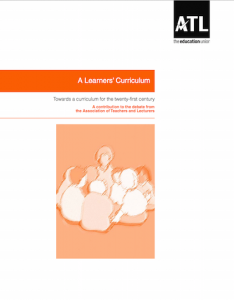The way I teach is by metaphor, by experience, and by exploration. Research, tasks, talking, and not necessarily by directly telling anyone how to do something. That is all good, but sometimes it is useful to talk about something head on. Here we go…
What Is A Curriculum ?
below are a few very useful readings that DO deal with this head on, and I think it is time to introduce and discuss it.
 At this point in MUS654 we have covered lots of the basics, satellite topics, and really become conversant with relating these to our own practice. Now I am asking you to take a step back from the specific setting of music teaching for a moment and look at a bigger picture of learning. Hopefully as you begin to piece together the bits of the puzzle to create that learning-picture for your student, you will have a more clear idea of how and why you have chosen to arrange the pieces in that way, for your curriculum. (Photo by ned the head CC BY-NC-ND)
At this point in MUS654 we have covered lots of the basics, satellite topics, and really become conversant with relating these to our own practice. Now I am asking you to take a step back from the specific setting of music teaching for a moment and look at a bigger picture of learning. Hopefully as you begin to piece together the bits of the puzzle to create that learning-picture for your student, you will have a more clear idea of how and why you have chosen to arrange the pieces in that way, for your curriculum. (Photo by ned the head CC BY-NC-ND)
Let’s beginning with some reading…
- Smith, M. K. (1996, 2000) ‘Curriculum theory and practice’ the encyclopaedia of informal education,www.infed.org/biblio/b-curric.htm.
The article opens with:
“Curriculum theory and practice. The organization of schooling and further education has long been associated with the idea of a curriculum. But what actually is curriculum, and how might it be conceptualized? We explore curriculum theory and practice and its relation to informal education.”
It is incredibly well presented and goes on to discuss curriculum in four different ways:
- Knowledge to betransmitted.
- Distinct aims, skills, or learning outcomes–product.
- Process.
- Praxis.
(yes, I had to look up the word praxis too, and the link on it- on the word itself, above- does help. It’s one of those words people use, but might not really be confident with what it means.)
Going through these different types of curriculum and reading about the relationships can be a basis for you to use your own knowledge to connect these to music learning. There will be some of each of these four types of curriculum that you may have first hand experience with, or associate with- in musical and other learning experiences.
As the article unfolds, and you get to the Curriculum as Process and Curriculum as Praxis sections, this is where I hope you find real connection and inspiration with your own work in preparing a private music curriculum. Remember, most of the article is geared for classroom teaching, which is fine, but sometimes the problems presented do not arise in the same way in a 1-to-1 setting.
-
Read the Curriculum Theory and Practice article HERE.
Next up on the reading list
for the next few days is an article by Adam Heidebrink-Bruno for the online journal of learning, teaching, and technology: Hybrid Pedagogy. This article is also not a music article, and in particular it is pitched at a typical university level course and the type of handbook or document that might be associated with it. He speaks of a syllabus, and in a thought provoking way unpicks some of the clichés that tend to appear in a class syllabus without much thought. When communicating with people, there should be thought. As teachers, everything we do, say, and hesitate to do- all has an impact. When you have the opportunity to put something in print, so people can look at it again and again, and refer to it, take the time to consider how it is received? Sometimes we are bound by required formats, and perhaps that can be avoided, or supplemented… The point of this article is to make you think, to get the cogs turning.
Cathy Davidson, Professor of English and Director of the Futures Initiative at City University New York (CUNY) explains her own experience with devising a syllabus and unfolding a student-centred curriculum in her own teaching. She details the specifics of how it happened, what she had to do to trust the students, and how they came to create what would be their class.
-
This is part 3 in her series: How to Get Started in Student-Centered Learning
The interchange between teacher and student, on every level of learning – from feedback on progress to the fundamental direction of learning, which can include the direct content of the course – cannot be underestimated. It is very difficult to achieve as there are no end to the possible problems. One basic problem is that the student(s) have to buy into what you are doing. If you have a class of 1 or 30 and they are not on board with you or the teaching, then all the creativity and student-centredness in the world will not make them commit, develop, or carry the learning forward. Don’t give up if you feel like you are in that situation – it is certainly possible to inspire your students to be involved, and when you do turn around a class or an individual who was not previously on the same learning and teaching page as you, that is magic and worth all the effort and dedication that is required of you to achieve that process.
The last of the readings
(for this page at least!) came to my attention from a blog post by Steve Wheeler where he introduced and summarised the writings of Professor Mike Newby in a publication by ALT (the Association of Lecturers and Teachers). The introduction gives us a flavour of the document:
“It proposes that non-hierarchical, self-managed networks will become characteristic organisational features of the middle years of the twenty-first century, and that we must therefore prepare children and young people for a networked world. It concludes that if learners are to flourish and thrive in the decades to come, they will need an experimental, progressive curriculum – one focused on the learner – where moulds will be broken and traditional barriers between disciplines and subjects will start to crumble.”
And within the document there are discussions of three types of curriculum:
In Steve’s post he introduced the document by Newby and added his own thoughts on each of the curriculum types. I added a comment, and perhaps you might continue the conversation….
My hope is that these engage you to think, and spur you on further as you develop something for your own learners (and possibly for your own learning). As always, comments, questions, observations, and thoughts are welcomed and invited.
Remember, we learn from one another when our ideas have the chance to escape the confines of our own minds. You can always tweet with the hashtag #MUS654
Image by mkhmarketing CC BY
Featured image by Ian Foss CC BY-NC-ND


Thanks Laura. I’m working on my courses currently to launch three different courses (2 sections of one of them) starting next week here on campus at the Tec de Monterrey in Guadalajara.
This will be my first time teaching one of the classes so I’m doing a much deeper dive into how to structure (and leave open) the class. These links are very useful so this was very timely indeed.
Also I thank you for giving credit in all the images and resources. This is something that I always stress with my students since they all blog during the course.